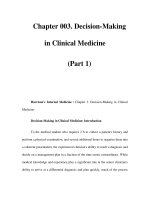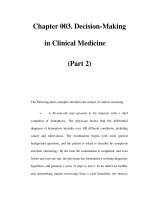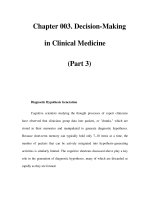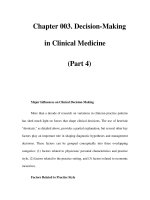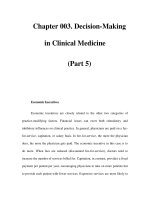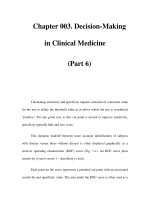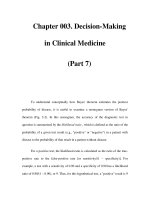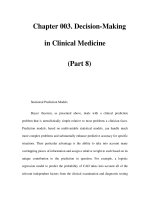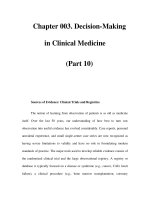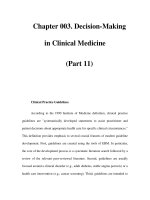Chapter 003. Decision-Making in Clinical Medicine (Part 11) docx
Bạn đang xem bản rút gọn của tài liệu. Xem và tải ngay bản đầy đủ của tài liệu tại đây (13.86 KB, 5 trang )
Chapter 003. Decision-Making
in Clinical Medicine
(Part 11)
Clinical Practice Guidelines
According to the 1990 Institute of Medicine definition, clinical practice
guidelines are "systematically developed statements to assist practitioner and
patient decisions about appropriate health care for specific clinical circumstances."
This definition provides emphasis to several crucial features of modern guideline
development. First, guidelines are created using the tools of EBM. In particular,
the core of the development process is a systematic literature search followed by a
review of the relevant peer-reviewed literature. Second, guidelines are usually
focused around a clinical disorder (e.g., adult diabetes, stable angina pectoris) or a
health care intervention (e.g., cancer screening). Third, guidelines are intended to
"assist" decision-making, not to define explicitly what decisions should be made in
a particular situation. The primary objective is to improve the quality of medical
care by identifying areas where care should be standardized, based on compelling
evidence.
Guidelines are narrative documents constructed by an expert panel whose
composition is often chosen by interested professional organizations. These panels
vary in the degree to which they represent all relevant stakeholders. The guideline
documents consist of a series of specific management recommendations, a
summary indication of the quantity and quality of evidence supporting each
recommendation, and a narrative discussion of the recommendations. Many
recommendations have little or no supporting evidence and, thus, reflect the expert
consensus of the guideline panel. In part to protect against errors by individual
panels, the final step in guideline construction is peer review, followed by a final
revision in response to the critiques provided.
Guidelines are closely tied to the process of quality improvement in
medicine through their identification of evidence-based best practices. Such
practices can be used as quality indicators. Examples include the proportion of
acute MI patients who receive aspirin upon admission to a hospital and the
proportion of heart-failure patients with depressed ejection fraction who are on an
ACE inhibitor. Routine measurement and reporting of such quality indicators can
produce selective improvements in quality, since many physicians prefer not to be
outliers.
Conclusions
In this era of EBM, it is tempting to think that all the difficult decisions
practitioners face have been or soon will be solved and digested into practice
guidelines and computerized reminders. However, EBM provides practitioners
with an ideal rather than a finished set of tools with which to manage patients. The
significant contribution of EBM has been to promote the development of more
powerful and user-friendly EBM tools that can be accessed by the busy
practitioners. This is an enormously important contribution that is slowly changing
the way medicine is practiced. One of the repeated admonitions of EBM pioneers
has been to replace reliance on the local "gray-haired expert" (who may be often
wrong but is rarely in doubt) with a systematic search for and evaluation of the
evidence. But EBM has not eliminated the need for subjective judgments. Each
systematic review or clinical practice guideline presents the interpretation of
"experts" whose biases remain largely invisible to the review's consumers. In
addition, meta-analyses cannot generate evidence where there are no adequate
randomized trials, and most of what clinicians confront in practice will never be
thoroughly tested in a randomized trial. For the foreseeable future, excellent
clinical reasoning skills and experience supplemented by well-designed
quantitative tools and a keen appreciation for individual patient preferences will
continue to be of paramount importance in the professional life of medical
practitioners.
Further Readings
Balk EM et al: Correlation of quality measures with estimates of treatment
effect in meta-
analyses of randomized controlled trials. JAMA 287:2973, 2002
[PMID: 12052127]
Del Mar C et al:
Clinical Thinking: Evidence, Communication and
Decision Making. Malden, Mass., Blackwell, 2006
Grimes DA et al: Refining clinical diagnosis with likelihood ratios. Lancet
365:1500, 2005 [PMID: 15850636]
Haynes RB et al: Clinic
al Epidemiology: How to Do Clinical Practice
Research. Philadelphia, Lippincott Williams & Wilkins, 2006
Peterson ED et al: Association between hospital process performance and
outcomes among patients with acute coronary syndromes JAMA 295:1912, 2006
[PMID: 16639050]
Reilly BM et al: Translating clinical research into clinical practice: Impact
of using prediction rules to make decisions. Ann Intern Med 144:201, 2006
[PMID: 16461965]
Sanders GD et al: Cost-effectiveness of screening for HIV in the era o
f
highly active antiretroviral therapy. N Engl J Med 352:570, 2005 [PMID:
15703422]
